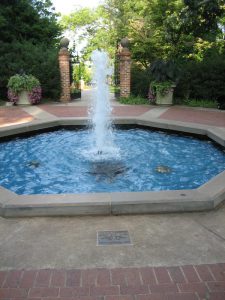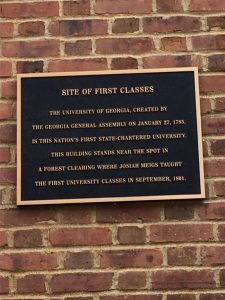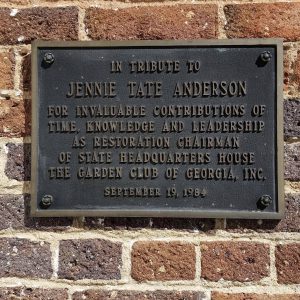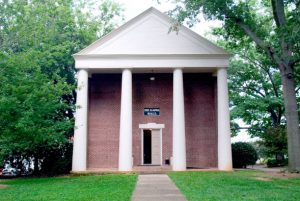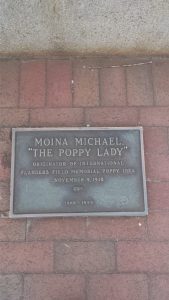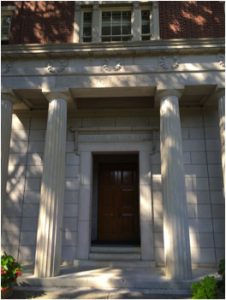The Hubert Bond Owens Plaza Fountain was erected for Hubert Bond Owens, who established the University of Georgia’s landscape architecture program and was its only professor for the first nine years. He graduated with a B.S. from the University of Georgia in 1926, with his studies focused on horticulture, landscape gardening, and agriculture. He also earned a Masters in education so that he could teach students about environmental design for over 45 years. In 1969, Hubert Bond Owens was named the first dean of the School of Environmental design. On top of his teaching career, he also designed the Founders Memorial Garden at the University of Georgia.
Old College
Old College is the oldest building at the University of Georgia. It was constructed in 1806, modeled after Connecticut Hall at Yale. The building was the first permanent structure at the university, following a temporary log cabin that had been used for instruction while Old College was being constructed. The building served as a place of instruction and a dormitory for UGA’s first classes, and continued to be used as such intermittently until World War Two. Besides its use by the students, Old College has also served important function in several wars. Old College was the site of a Confederate hospital for war refugees during the American Civil War, and as a dormitory by the US Navy for those attending the Pre-Flight School. Though it is now referred to as Old College, the building was originally christened Franklin College. The original name fell out of favor in the 1820s when New College was built nearby, but its legacy lives on in the Franklin College of Arts and Sciences, which is currently housed in Old College. Despite extensive renovations, Old College remains a fixture of North Campus and a symbol of the earliest years of UGA. To commemorate Old College’s historical significance to the university, a plaque was installed outside the building by the Georgia Historical Society and the University of Georgia in 2006 on the occasion of Old College’s bicentennial.
Site of First Classes
The Site of First Classes Plaque is embedded into the outer wall of Old College, on the spot where Josiah Meigs, the second president of the University of Georgia, first held classes. The site that would become UGA was chosen in 1801 by a committee consisting of John Milledge, Hugh Lawson, George Walton, John Twiggs, and Abraham Baldwin. On a hill near the Oconee River, along which springs descended to feed the majestic oak and hickory trees, the committee selected the spot where the university would be built. In September 1801, President Meigs sat atop a stool below a white oak tree and instructed his students in the basics of Latin and Greek. These humble beginnings marked the birth of an institution. That single stool in the forest gave way to the construction the entire university. In 2001, President Michael Adams recreated the first classes near the original site and taught a class dressed as Josiah Meigs. Though the spot where the first classes were held has been built over by Old College, its legacy remains in a plaque on the outer wall of the building.
Jennie Tate Anderson Plaque
Jennie Tate Anderson, also known as “Virginia,” graduated from Emory University in 1933 with Bachelors of Arts in History and Governmental Studies. Originally from Marietta, Georgia, she was significantly involved in her community. She was an active member of Garden Club of Georgia, which also was the Ladies Garden Club of Athens. She served as a president of the club from 1969-1971. Mrs. Anderson was an important chairman of Georgia’s “Keep America Beautiful” foundation. Also, she was the co-founder of the Cobb Landmarks and Historical Society. With her husband, James T. Anderson, Jr., she heavily supported the Marietta community through various foundations. She was a board member of other local organizations: the Fulton Federal Savings and Loan Bank, the Northwest Georgia Girl Scout Council, and many more. Her plaque is located at the University of Georgia’s Founders Memorial Garden to honor her invaluable contributions and passion to serve the community.
Sources:
https://findingaids.library.emory.edu/documents/anderson1183/
http://gardenclub.uga.edu/history.html
Ida Naylor Hilton Plaque
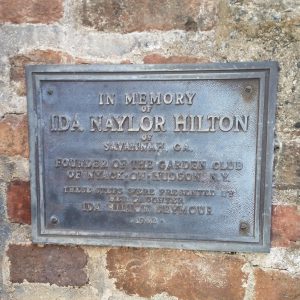 The plaque, located at the University of Georgia’s Founders Memorial Garden, is dedicated to Ida Naylor Hilton. She was the wife of Joseph Hilton who was the founder and owner of Hilton & Dodge Lumber Company in Savannah, Georgia. Both Ms. and Mr. Hilton were significantly involved in the community and were socially active people. In 1912, Mrs. Hilton founded the Garden Club of Nyack on Hudson, New York. The organization assisted local garden and “civic beautification” projects. Her daughter, Ida Hilton Seymour, who presented the stairs of Memorial Garden house, dedicated the plaque to honor her mother.
The plaque, located at the University of Georgia’s Founders Memorial Garden, is dedicated to Ida Naylor Hilton. She was the wife of Joseph Hilton who was the founder and owner of Hilton & Dodge Lumber Company in Savannah, Georgia. Both Ms. and Mr. Hilton were significantly involved in the community and were socially active people. In 1912, Mrs. Hilton founded the Garden Club of Nyack on Hudson, New York. The organization assisted local garden and “civic beautification” projects. Her daughter, Ida Hilton Seymour, who presented the stairs of Memorial Garden house, dedicated the plaque to honor her mother.
Sources:
https://books.google.com/books?id=zv9HAQAAMAAJ&pg=PA716&lpg=PA716&dq=ida+hilton+seymour+ga&source=bl&ots=fyV6T3CZ4-&sig=nfvxZPiVC9-VOO2sXcD4kETB7aY&hl=en&sa=X&ved=0ahUKEwii8ImMmMjPAhVMJCYKHUa2ANYQ6AEIQjAH#v=onepage&q=ida%20hilton%20seymour%20ga&f=false
The Sundial
The Sundial was gift from the graduating Class of 1908 and was erected in a very important spot on campus. A few months before graduation a lightening bolt struck the famous “Toombs’ Oak” in front of the chapel and felled it. The tree was made famous by the legend that Robert Toombs gave a speech so moving under that tree during graduation events inside the chapel that everyone inside left to hear the young orator. This was controversial because Toombs, an excellent student, had been expelled a few years earlier for fighting. He later went on to become Secretary of State for the Confederacy. The Sundial was put on that famous spot to mark it for future generations. The face of the dial was replaced with an accurate reproduction that still have all the original detail; detail that can now be appreciated without 100 plus years worth of weathering.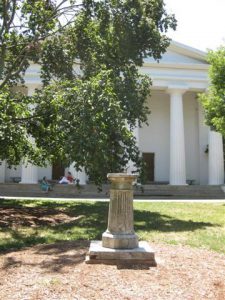
Candler Hall
Candler Hall was built in 1901 as a residence hall for students at the University. It was named after Allen D. Chandler, then Governor of the State. Prior to his appointment to public office Chandler was a Colonel in the Confederate Army where he fought in many large battles of the war such as Vicksburg, Kennesaw Mountain, and Atlanta. Upon returning home to Georgia Candler built upon his legal education which he received from Mercer University and sought public office. Candler was of the belief that the Democratic Party was to be a “white only” party and that it had the right to exclude African Americans. He did do a great service to the state in his last decade of life through his compilation 30 volumes of Georgia History. Today the building serves as the main office for the School of Public and International Affairs.
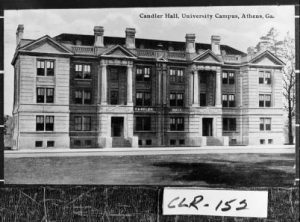
Phi Kappa Hall
Phi Kappa Hall can be found at the intersection between Broad and Jackson Street on UGA’s North Campus. The hall cost a total of $5,000 and was erected in 1836. It was dedicated by John Calhoun, then-vice president, native of South Carolina, and Yale alumni, and the dedication ceremony was attended by such prominent and local names as Joseph Lumpkin and Howell Cobb. The building was once a fraternity house, but during the Civil War, it housed some of the Union Army, serving as a stable and, for a short time, a brothel. Today, it gives location for the Phi Kappa Literary Society, one of the only still-active literary societies in America. For many years until 1991, the hall was defunct and served no abject purpose proceeding the disintegration of the Society; it was placed under construction to repair some of the older parts of the building. In 2005, the building was rededicated with a debate between members of the newly-reformed Phi Kappa Literary Society over the Iraqi independence struggle, mirroring the first debate ever held by the Phi Kappa Literary Society after its formation on whether the United States should help Greece in its war for independence. Presently, Phi Kappa Hall is the seventh-oldest building on campus.
The Moina Michael Plaque
This plaque, which is dedicated to Moina Michael, also known as “The Poppy Lady”, stands in a strip of land on Broad Street, across from the UGA Arch. Moina was a Normal School teacher in her life and was a professor at the University of Georgia when the U.S. became involved in first World War in 1917. She saw it as a call to action, taking a leave of absence from teaching to voluntarily train members of the World Young Women’s Christian Association in New York. After the war, Michael began teaching courses to veterans back on UGA campus and, inspired by the battle poem In Flanders Field by John McCrae- including the line “in Flanders Field the poppies blow”- began wearing a red poppy each day in commemoration. The end of the war facilitated the return of millions of injured and newly disabled men. Seeing this, Moina began to popularize the idea of the poppy as a symbol for World War I veterans and aimed to fund their care with programs selling silk poppies to the public. Her mission consisted of both raising money for the welfare of veterans and ensuring that the poppy would become the official symbol for veterans of war in the eyes of the government, the public, and the world. At the time of her death, sales of her “remembrance poppies” had raised over $200 million. Today, the tradition of using or planting red poppies for the remembrance of war survivors continues, most prominently on Remembrance Day in the U.K. and similar holidays in other commonwealth nations.
Harold Hirsch Hall
Harold U. Hirsch (1881-1939), of Atlanta, Georgia, was an distinguished alumni of the University of Georgia. Upon graduation in 1901, Mr. Hirsch studied law at Columbia University Law School, receiving his degree in 1904. He returned to Atlanta, where he eventually served as general counsel for the Coco-Cola Company for thirty years. During counsel he fought for the trademark “Coca-Cola”, making contributions to the development of fair trade law. Mr. Hirsch also served his community in a variety of ways, establishing a scholarship for young students, and as Chairman of the Citizen’s Advisory Committee and of the Georgia Citizen Educational Movement. The Harold Hirsch building, which housed The Lumpkin Law School and The Alexander C. King Memorial Hall, was dedicated in October 29, 1932. The Red and Black wrote that “Harold Hirsch Hall is a perpetual reminder of Georgia’s most loyal living alumnus, a man who more than any other has helped the University of Georgia with all the ability of a great mind and all the fervor of an unselfish spirit.”

